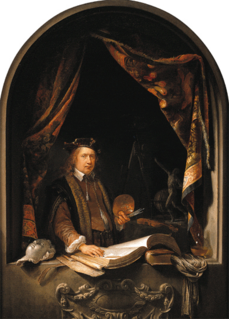
Gerrit Dou, also known as GerardDouw or Dow, was a Dutch Golden Age painter, whose small, highly polished paintings are typical of the Leiden fijnschilders. He specialised in genre scenes and is noted for his trompe-l'œil "niche" paintings and candlelit night-scenes with strong chiaroscuro. He was a student of Rembrandt.

Carel de Moor was a Dutch Golden Age etcher and painter. He was a pupil of Gerard Dou.

Frans van Mieris, the elder, was a Dutch Golden Age genre and portrait painter. The leading member of a Leiden family of painters, his sons Jan (1660–1690) and Willem (1662–1747) and his grandson Frans van Mieris the Younger (1689–1763) were also accomplished genre painters.

Willem van Mieris was an 18th-century painter from the Northern Netherlands.

Godfried Schalcken or Gottfried Schalken was a Dutch genre and portrait painter. He was noted for his mastery in reproducing the effect of candlelight, and painted in the exquisite and highly polished manner of the Leiden fijnschilders.
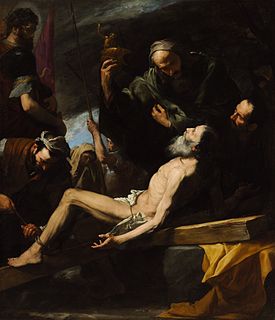
Tenebrism, from Italian tenebroso, also occasionally called dramatic illumination, is a style of painting using especially pronounced chiaroscuro, where there are violent contrasts of light and dark, and where darkness becomes a dominating feature of the image. The technique was developed to add drama to an image through a spotlight effect, and is common in Baroque paintings. Tenebrism is used only to obtain a dramatic impact while chiaroscuro is a broader term, also covering the use of less extreme contrasts of light to enhance the illusion of three-dimensionality.

Utrecht Caravaggism refers to the work of a group of artists who were from, or had studied in, the Dutch city of Utrecht, and during their stay in Rome during the early seventeenth century had become distinctly influenced by the art of Caravaggio. Upon their return to the Dutch Republic, they worked in a so-called Caravaggist style, which in turn influenced an earlier generation of local artists as well as artists in Flanders. The key figures in the movement were Hendrick ter Brugghen, Gerrit van Honthorst and Dirck van Baburen, who introduced Caravaggism into Utrecht painting around 1620. After 1630 the artists moved in other directions and the movement petered out. The Utrecht Caravaggisti painted predominantly history scenes and genre scenes executed in a realist style.
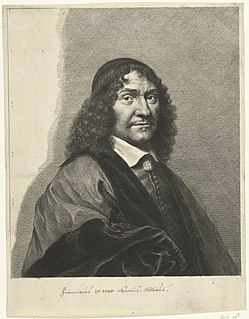
Franciscus Sylvius, born Franz de le Boë, was a Dutch physician and scientist who was an early champion of Descartes', Van Helmont's and William Harvey's work and theories. He was one of the earliest defenders of the theory of circulation of the blood in the Netherlands, and commonly falsely cited as the inventor of gin – others pin point the origin of gin to Italy.

Dutch Golden Age painting is the painting of the Dutch Golden Age, a period in Dutch history roughly spanning the 17th century, during and after the later part of the Eighty Years' War (1568–1648) for Dutch independence.
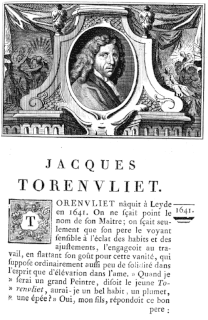
Jacob Toorenvliet (1640–1719) was a Dutch Golden Age painter of genre works.

Pieter Cornelisz van Slingelandt was a Dutch Golden Age portrait painter who had been a pupil of Gerard Dou and is known as one of Leiden's fijnschilders..
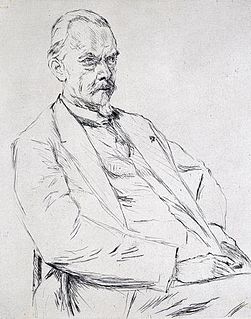
Cornelis Hofstede de Groot, was a Dutch art collector, art historian and museum curator.

Louis Bernard Coclers was a Southern Netherlandish portrait painter and engraver who worked mainly in Liège, Maastricht, Leiden and Amsterdam.

The Leiden Guild of Saint Luke refers to three artist collectives in Leiden; the Leidsche St. Lucas Gilde dating from 1648, the newer Leidse Tekenacademie established in 1694, and the collective known as Ars Aemula Naturae established in 1799.

Jacobus Josephus Eeckhout or Jacques Joseph Eeckhout was a Flemish painter, sculptor, pastellist, water-colourist and lithographer and a Director of the Royal Academy of Art in The Hague.

Merry company is the term in art history for a painting, usually from the 17th century, showing a small group of people enjoying themselves, usually seated with drinks, and often music-making. These scenes are a very common type of genre painting of the Dutch Golden Age and Flemish Baroque; it is estimated that nearly two thirds of Dutch genre scenes show people drinking.
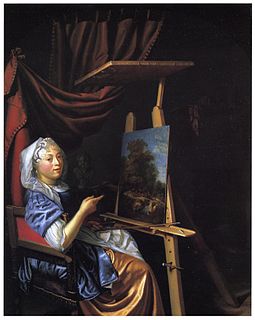
Maria Schalcken (1645–1699), was a Dutch Golden Age painter. She was a sister and pupil of Godfried Schalcken.

Schalcken the Painter is a British television horror film based on the 1839 story "Strange Event in the Life of Schalken the Painter" by Sheridan Le Fanu, and stars Jeremy Clyde as Godfried Schalcken and Maurice Denham as Gerrit Dou. It aired on the BBC as an episode of Omnibus on 23 December 1979, following in the tradition of A Ghost Story for Christmas.
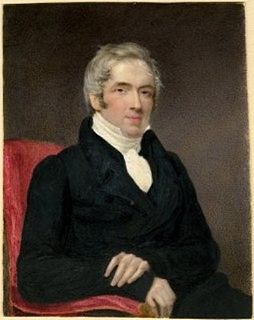
John Smith (1781–1855) was a 19th-century British art dealer who developed the concept of the catalogue raisonné.






















